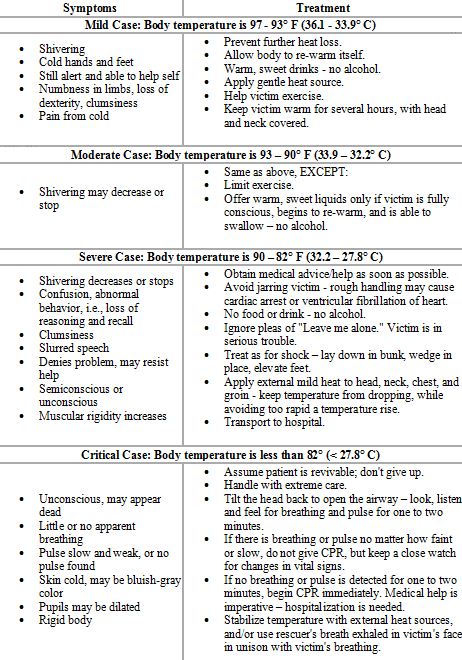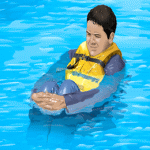 By Bob Currie, Vessel Examiner
By Bob Currie, Vessel Examiner
United States Coast Guard Auxiliary Flotilla 081-06-08
USCG Auxiliary Flotilla 081-06-08 is based at Coast Guard Station Galveston. The Auxiliary’s vessel examiners perform safety checks on all types of recreational boats. The list of equipment required by federal law is very minimal; however, the Coast Guard has several recommendations for consideration by the prudent and safe recreational boater. Many of the recommendations for recreational boaters are actually required of commercial vessels.
Hypothermia
Immersion into cold water can lead to hypothermia, the abnormal reduction of body temperature. Hypothermia can induce rapid, uncontrolled breathing, cardiac arrest, and other physical conditions, and can easily result in death from cold or drowning. Hypothermia is essentially a condition where bodily temperature drops too low to perform normal voluntary or involuntary functions. Cold water causes “immersion hypothermia”, which can cause damage to extremities or the body’s core, including unconsciousness or death. Prolonged exposure to what one may consider to be warm water can lead to hypothermia. Only last year we had a boater death in Galveston East Bay due to exposure, which is another way of saying hypothermia. Hypothermia will occur even with water temperatures in the 80’s if the person is exposed to that temperature long enough. Alcohol consumption can speed the onset and progression of hypothermia. Alcohol impairs motor skills, magnifies the torso reflex, and affects clear thinking. As the alcohol level in a person’s body increases, coordination abilities decrease. At high doses, alcohol damages thermoregulation, which lowers the body’s resistance to cold water.
Hypothermia Symptoms
When you first fall into cold water you gasp (torso reflex). Next, your skin begins to cool, and your body constricts surface blood vessels to conserve heat for your vital organs. Blood pressure and heart rate increase. Muscles tense and shiver; this produces more body heat, but results in a loss of dexterity and motor control. As your body’s core temperature drops further, blood pressure, pulse, and respiration rates all decrease.
As conditions worsen, your mental attitude and level of consciousness change. Resisting help and acting irrational or confused are common indicators of hypothermia. As your core temperature drops dangerously low, you become semiconscious, then unconscious. Stress, shock, and low core temperatures may cause cardiac and respiratory failure.
Hypothermia sneaks up on you, so you probably aren’t the best judge of whether or not you are hypothermic. Signs that a person is nearing a hypothermic state include shivering, poor coordination, and mental sluggishness. As hypothermia progresses, shivering ceases, coordination is severely impaired, and confusion is coupled with incoherence and irrationality. Severely hypothermic people have icy skin. Extreme lethargy merges with unconsciousness and they might appear dead.
The Torso Reflex
The torso reflex (also known as the gasp reflex or inhalation response) is a physiological reaction – an involuntarily gasp – that happens when a person suddenly enters cold water. The reflexive sucking in of air is a way for the body to rapidly increase oxygen intake into the lungs as a means of increasing survival. Some reported drowning victims don’t die as a result of poor swimming skills or the effects of hypothermia, but from the torso reflex. Occasionally the torso reflex causes victims to inhale water. A person can also die from cardiac arrest brought on by sudden entry into cold water.
Treating Hypothermia
First aid goals include:
• Preventing further heat loss,
• Re-warming the victim,
• Quickly getting professional medical help as needed.
Minimize the victim’s physical exertion when removing her or him from cold water. Rescuers may have to enter the water to get the victim. Once out of the water, gently remove wet clothing and cover the person with dry clothing or blankets. Protect the victim from wind, especially around the head and neck. Move them to a warm environment if possible and avoid re-exposure to the cold. Warm compresses and warm (not hot) liquids that are non-alcoholic and non-caffeinated also help to restore heat.
If you are helping a hypothermic person, be gentle; internal organs are sensitive to physical shocks. The victim should remain as inactive as possible so blood from their cold extremities won’t reach their core too quickly. A cold heart is particularly susceptible to ventricular fibrillation, an often fatal irregular heart beat. During all first aid efforts, watch for changes in the victim’s temperature and vital signs. “After drop” is a danger when re-warming hypothermia victims because cold blood in the extremities returns to the body core, lowering the core temperature further. Hypothermia victims with moderate to critical symptoms should see a medical professional as soon as possible.
Hypothermia Symptom and Treatment Chart
(Source: http://www.seagrant.umn.edu/coastal_communities/hypothermia#prevent )
The following general procedures assume a rescuer has no special medical training or equipment:

Cold Water Survival
 A boater operating in cold water should always wear a life jacket. Anyone forced to enter the water should button up all clothing, and, if possible, cover his or her head; enter the water slowly; keep the head out of the water; and assume the heat escape lessening posture (HELP). The HELP is an attempt to reduce heat loss enough to lessen the effect of hypothermia. It involves essentially positioning one’s knees together and hugging them close to the chest using one’s arms. Furthermore, groups of people can huddle together in this position to conserve body heat, offer moral support, and provide a larger target for rescuers. He or she should also attempt to climb aboard the overturned hull if it is still afloat. The HELP is demonstrated below:
A boater operating in cold water should always wear a life jacket. Anyone forced to enter the water should button up all clothing, and, if possible, cover his or her head; enter the water slowly; keep the head out of the water; and assume the heat escape lessening posture (HELP). The HELP is an attempt to reduce heat loss enough to lessen the effect of hypothermia. It involves essentially positioning one’s knees together and hugging them close to the chest using one’s arms. Furthermore, groups of people can huddle together in this position to conserve body heat, offer moral support, and provide a larger target for rescuers. He or she should also attempt to climb aboard the overturned hull if it is still afloat. The HELP is demonstrated below:
First Aid
Boaters are encouraged to take a first aid training course to prepare them to deal with medical emergencies that may arise while they are under way. First aid classes are available through the American Red Cross and other civic organizations. Some first aid courses include basic Cardiac Pulmonary Resuscitation (CPR) training. Many such courses are offered online, including CPR and First Aid courses.
Summary
Don’t go boating in water in which you are not prepared to be immersed in should you sink or capsize. Be prepared for such an occurrence by dressing accordingly, and carry emergency equipment in your dry locker such as blankets and towels. You can reduce exposure by climbing onto your hull if you capsize. Get out of the water if you can. Loss of body heat occurs much more rapidly in water than in the air, even if the air temperature is colder than the water temperature. Also, don’t forget to file a float plan. No one knew that the boater who died from exposure in Galveston East Bay was even on the water.
For more information on boating safety, please visit the Official Website of the U.S. Coast Guard’s Boating Safety Division at www.uscgboating.org. Questions about the U.S. Coast Guard Auxiliary or our free Vessel Safety Check program may be directed to me at [email protected]. I am available to perform free Vessel Safety Checks, and I will come to your location to perform them. SAFE BOATING!
[12-4-2017]

 Posted in
Posted in 























